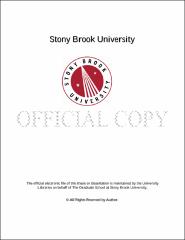| dc.identifier.uri | http://hdl.handle.net/11401/77159 | |
| dc.description.sponsorship | This work is sponsored by the Stony Brook University Graduate School in compliance with the requirements for completion of degree. | en_US |
| dc.format | Monograph | |
| dc.format.medium | Electronic Resource | en_US |
| dc.language.iso | en_US | |
| dc.publisher | The Graduate School, Stony Brook University: Stony Brook, NY. | |
| dc.type | Dissertation | |
| dcterms.abstract | Bacterial quorum sensing (QS) is an essential cell-to-cell communication system used by bacteria. Bacteria produce and detect small signaling molecules called autoinducers (AIs) to assess their surrounding bacterial population. Once the AI concentration reaches a threshold, the entire bacterial population undertakes a coordinated change in gene expression patterns. Thus, QS enables bacteria to orchestrate population-wide changes in behavior appropriate for different growth phases or environmental conditions. QS is widely spread among bacteria and regulates a wide array of biological functions that are critical for their survival. Controlled manipulation of QS may provide the means for the design of more selective antibiotics and improved bioproduction efficiency with engineered bacteria. Thus, understanding mechanisms of quorum sensing is of significant academic, medical and industrial interest. In this study, we report the identification and characterization of a nitric oxide (NO) responsive quorum sensing circuit in the marine pathogen Vibrio parahaemolyticus. We found that V. parahaemolyticus QS is regulated not only by AIs, but also by NO, through two-component signaling. V. parahaemolyticus detects NO through a nitric oxide/oxygen binding protein (H-NOX) and H-NOX regulates the activity of an H-NOX-associated histidine kinase (HahK). HahK ultimately modulates the activity of the QS master regulator, OpaR, through phosphoryl group transfer, and thus H-NOX/HahK participates in the V. parahaemolyticus QS circuit. In this thesis, we also present the development of a medium-throughput filter-binding assay for histidine kinase phosphorylation. A major bacterial signaling pathway, two-component signaling, is based upon phosphorylation and phosphotransfer events by histidine kinases and their partner proteins. In spite of its importance, understanding of two-component signaling is hindered by the lack of effective assay methods to quantify histidine kinase activity. To address this issue, we developed a carefully optimized filter-binding assay for kinase phosphorylation detection. We demonstrate the validity of the assay by monitoring phosphorylated histidine degradation under the proposed experimental conditions. Subsequently, we quantify kinase activities with respect to time, enzyme, and substrate concentrations, then determine their kinetic parameters. | |
| dcterms.available | 2017-09-20T16:52:07Z | |
| dcterms.contributor | Drueckhammer, Dale | en_US |
| dcterms.contributor | Boon, Elizabeth M | en_US |
| dcterms.contributor | Tonge, Peter | en_US |
| dcterms.contributor | El-Maghrabi, M. Raafat. | en_US |
| dcterms.creator | Ueno, Takahiro B. | |
| dcterms.dateAccepted | 2017-09-20T16:52:07Z | |
| dcterms.dateSubmitted | 2017-09-20T16:52:07Z | |
| dcterms.description | Department of Chemistry. | en_US |
| dcterms.extent | 101 pg. | en_US |
| dcterms.format | Monograph | |
| dcterms.format | Application/PDF | en_US |
| dcterms.identifier | http://hdl.handle.net/11401/77159 | |
| dcterms.issued | 2015-12-01 | |
| dcterms.language | en_US | |
| dcterms.provenance | Made available in DSpace on 2017-09-20T16:52:07Z (GMT). No. of bitstreams: 1
Ueno_grad.sunysb_0771E_12382.pdf: 4250752 bytes, checksum: 8b6d68b98a9dbaeff2abb0d9ecbd8d5d (MD5)
Previous issue date: 1 | en |
| dcterms.publisher | The Graduate School, Stony Brook University: Stony Brook, NY. | |
| dcterms.subject | filter-binding assay, H-NOX, Nitric oxide, NO responsive quorum sensing circuit, Quorum sensing, Two-component signaling | |
| dcterms.subject | Biochemistry | |
| dcterms.title | Characterization of bacterial multi-component regulatory systems: Nitric oxide, quorum sensing and | |
| dcterms.type | Dissertation | |

